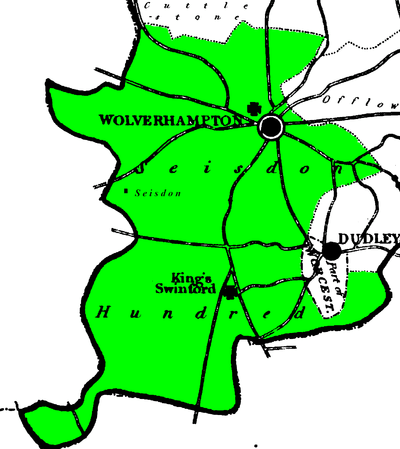Seisdon
Coordinates: 52°33′10″N 2°14′23″W / 52.5529°N 2.2398°W
Seisdon is a rural village in the county of Staffordshire approximately six miles west of Wolverhampton and the name of one of the five hundreds of Staffordshire. For population details as taken at the 2011 census see Trysull & Seisdon.
History
Placename evidence suggests a fairly early Anglo-Saxon origin. Certainly the village of Seisdon was of sufficient importance by the Norman Conquest to be the eponym of a hundred. The Domesday Book gives considerable information about land ownership in the Seisdon Hundred, but there is little to abstract about the village itself.
Seisdon was a hamlet within the parish of Trysull, lying one mile north-west of the village of Trysull, near the border with Shropshire.There is a narrow bridge of several arches over the river Smestow. On the county boundary there is a high position which formed an ancient entrenchment named Abbot's Wood (Apewood) Castle.[1]
Almost all of its residents were originally employed in the agricultural industry.
Seisdon Hundred
Each hundred was formed to support a military unit. Seisdon Hundred contains the smallest area of the five hundreds of Staffordshire, but it has a relatively high population density and agricultural productivity. It formed the south-western portion of the county, bounded on the west by Shropshire, on the south by Worcestershire, on the east by Offlow Hundred, and on the north by Cuttlestone Hundred. The old Forest of Brewood formed the boundary of Seisdon and Cuttleston.[2]
Seison Hundred was divided into North and South Divisions. each with their own chief Constable.
The Hundred contained Wolverhampton, the largest town of the county, and many populous villages, which were constituted into 18 parishes, part of two others and one extra parochial area. Wolverhampton parish contained several townships some of which were in Cuttlestone and Offlow Hundreds. The parishes in 1834 were as follows:[3]

| Parishes in Seisdon Hundred |
|---|
| Bobbington (partly in Shropshire) |
| Broome |
| Bushbury |
| Clent |
| Codsall |
| Enville |
| Himley |
| Kingswinford |
| Kinver |
| Old Swinford (incl Amblecote) |
| Patshull |
| Pattingham (partly in Shropshire) |
| Penn |
| Rowley Regis |
| Sedgley |
| Tettenhall |
| Trysull (and Seisdon) |
| Upper Arley (Over Arley) |
| Wolverhampton |
| Wombourn |
| Woodford (Extra Parochial) |
The Hundred presented a great diversity of soil and scenery. It was rich in coal, ironstone, lime, and freestone, and renowned for its extensive mines and iron works, and for the manufacture of a great variety of articles in iron, steel, and other metals.[4]
There was a Seisdon Rural District from 1894 to 1974.
Etymology
The name appears to mean "hill of the Saxons",[5] deriving from the Anglo-Saxon words Seis meaning Saxon and Dun meaning hill. The first element may alternatively be a personal name. A large number of Hundred names refer to hills or mounds. Some of these at least are very conspicuous hills, which afford a commanding view of the countryside for miles around. It seems likely that such sites were chosen as being' remote, and where interference was most easily avoided.[6]
Famous people
- Mark Speight (1965–2008) – Television presenter and actor
- Mick McCarthy - football manager, with Wolverhampton Wanderers, lived in the area
- Jamie O'Hara - footballer, with Wolverhampton Wanderers, lives in the area
See also
- Trysull & Seisdon, administrative and ecclesiastical parish
- Trysull
- Seisdon Rural District
References
- ↑ History, Gazetteer and Directory of Staffordshire by William White, pub. Sheffield, 1834 (section on Trysull Parish)
- ↑ The English Hundred Names, by Olof Anderson, Lund (Sweden), 1934. Page 145
- ↑ History, Gazetteer and Directory of Staffordshire by William White, pub. Sheffield, 1834. Page 163
- ↑ History, Gazetteer and Directory of Staffordshire by William White, pub. Sheffield, 1834
- ↑ W.H. Duignan, Notes on Staffordshire Place Names, London: Henry Frowde, 1902
- ↑ The English Hundred Names, by Olof Anderson, Lund (Sweden), 1934. Page 145
External links
 Media related to Seisdon at Wikimedia Commons
Media related to Seisdon at Wikimedia Commons
